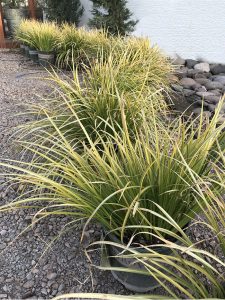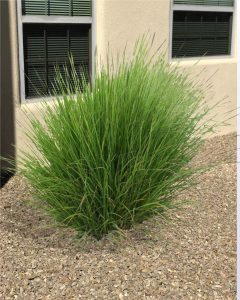
Grasses for the Southwest
Grasses for the Southwest. Most Grasses are easy to take care of. They are not susceptible to insects and rarely need to be fertilized. Most will go dormant during the winter seasons. You can cut them down low to the ground, and they will vigorously grow back during spring.
Pampas Grass or Cortalderia Selloana.
This is a fast-growing ornamental grass. It is usually evergreen in warmer climates. The normal variety grows to about 10ft high and 20ft wide and should be planted in groups. It has showy spiked flower plumes and razor-edged leaves (ouch)! The dwarf variety called ivory tower is mainly sold at your local nursery. It likes full sun and is very drought tolerant. It grows best at about 6500 ft. elevation.

More on the Pampas Grass for Landscaping
Fountain Grass or Pennisetum spp.
Also known as the “Purple Fountain Grass”. Most grow about 3ft. tall and about 5ft. wide. Purple fountain grass or Pennisetum alopecuroides is a favorite among southwestern New Mexicans. Nice feathery plumes in the fall. They all like full sun and well-fertilized soil. Nice purple undertones for good natural color. It is a tender perennial in the higher elevations of the Southwest. This grass loves the southern New Mexico and West Texas regions.
Blue Fescue or Festuca caesia.
Nice mounding dark pale bluegrass with ornamental flowers. It is a perennial and can be used as a ground cover. Loves colder climates but will tolerate drought conditions. Likes full sun and or shade. This ornamental grows to about 1-2 ft. tall and wide and stays green year-round. Ask your local nursery for more advice.
Use it as a border plant or place it in a container for a nice show of bluegrass during the spring season. It will produce a nice-looking plume in the fall.

Pink Muhly Muhlenbergia capillaris

USDA Hardiness Zone: 6 – 9. Lots of tall, delicate flower stems create a vibrant rosy, red haze over the fine-textured, leaves. They’ll remain eye-catching all winter long. Isn’t that what you want in your garden? This grass serves as a fantastic ground cover when teamed up with shrubs and trees, creating a lush visual tapestry. Thriving under the blazing Southwestern sun, it can handle poor soil with ease. It’s commonly known as Mexican feather grass. Also called Regal Mist.Pink Muhly Grass
Fountain Grass (alopecuroides)
This grass produces a clump of narrow, half-inch shiny green leaves that most landscapers and gardeners use for the flowering spikes it produces. They look great during the early through late fall seasons. Plant them as a showy single specimen or lined up for edging. Good in USDA zones 4-9

Japanese Silver Grass Miscanthus Sinensis ‘Variegatus’
USDA Hardiness Zone: 5 – 9 Excellent arch-type grass with silvery white plumes. Dark green blades with creamy white stripes. An excellent choice for textural contrast in perennial or shrub beds. Put them in a container or use them as a border plant to hide utility boxes. See images of this grass over at Monrovia.com
Variegated sweet Grass Plant
Variegated Sweet Flag Grass. It does good in the Southwest and is considered an evergreen grass in warmer regions such as the lower elevations of the Southwest. Rich yellow and green long leaves that sway back and forth when the days are windy. Grows about 1ft. tall and 8″ wide but will grow larger in its tenth year or so.
Deer Grass (Muhlenbergia rigens)
This grass is perfectly suited for the desert Southwest, thriving in dry conditions and proving easy to care for. It’s ideal for those in gardening zones 5 through 11. If you’ve been eyeing Pampas grass but want something smaller and more manageable, this is a great alternative. During winter, it transforms into a charming pale white shade, adding a unique touch to your landscape even in the colder months. Plus, its low maintenance nature makes it an excellent choice for busy gardeners. Why not give it a try and see how it can elevate your outdoor space?
Grasses for the Southwest



